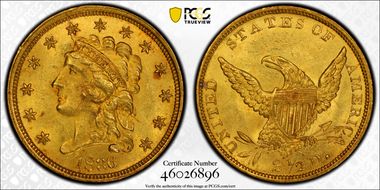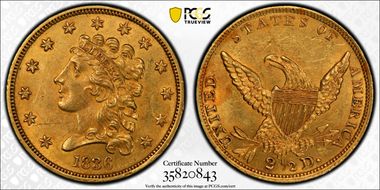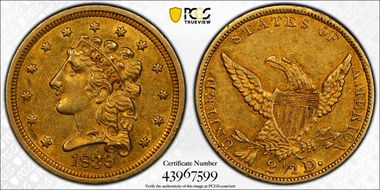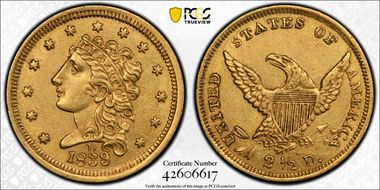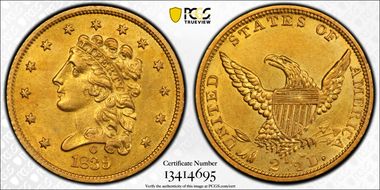JD's Classic Head Quarter Eagle CAC set 的钱币相册
CAC/OGH, HM-2, R-3. Obverse 2: Large indent in hair at bottom of the portrait. Reverse B: Widely spaced A M in AMERICA; split berry. This example has vivid golden-olive surfaces which are further enlivened by intense luster in a satin to semi-reflective finish. It is well struck with bold details throughout. PCGS Gen 3.0 Holder. Stack’s Bowers 3/23: 7015.
CAC, HM-2, R-3. Obverse 1: The Mint used a single obverse die to strike all 1835 quarter eagles. Reverse B: Widely spaced A M in AMERICA split berry; the same as 1834 HM-2. This is the most common pairing in 1835 representing over 85% of the assumed survivors. As with all 1835 Quarter Eagles, the central devices are weakly struck but this example has better definition than most. The color is green-gold and the surfaces are prooklike. A beautiful example of this date. Purchased from Crescent City Numismatics.
CAC, HM-4, Script 8, “late/intermediate” die state, R-1. Obverse 4: Script 8; Curved Profile; Star 6 points to lowest portion of first hair curl. Reverse E is the same as HM-3 and 1835 HM-3 and is the only reverse in 1836 with no berry. Well struck despite the deteriorating condition of the obverse die. The luster is muted, and the color is orange-gold with scattered hints of cherry-red. The obverse has a bisecting die crack which runs from the left of star 6 through Liberty and the field between stars 12 and 13. This crack is met above the ear with a crack to the lower jaw. The reverse does not have the “normal” crack from the left wing to through the lower base of S but does have a shallow crack from the top left of the shield to the Eagle’s beak. Heritage 12/22: 3581.
CAC, HM-1, Block 8, R-3. Obverse 1: Curved profile and large indent in hair at bottom of portrait; this obverse die is unique. Reverse F: VERY weak detached tongue; 3rd Arrowhead under right base of A. This example is green-gold with orange-gold toning and pleasing cartwheel luster. The strike is very strong except for some minor weakness on the hair below the Liberty Band. Purchased from DLRC.
CAC, HM-1, R-3. Obverse 1 (unique) and Reverse H which is the same as 1837 HM-3; there is only one die pairing in 1838. Beautiful frosty luster adorns green gold surfaces. The strike is extremely strong and there are no significant contact marks. The obverse has a wide rim and small denticles. It would be a pleasure if all coins were graded this conservatively. Purchased from Crescent City Numismatics.
CAC, HM-1, R-4. There is a single die pair known. The obverse is unique; the reverse was subsequently used for 1839-C HM-1; there is only one die pairing in 1838-C. Virtually Mint State, this impressive piece has a trace of rub on the high points with minuscule handling marks. Both sides display lustrous green-gold surfaces with gorgeous peripheral rose toning. Although not clearly visible on the PCGS image, there is a distinct die crack from the left shield through the eagle’s lower beak. This crack may have led to the soft strike at the juncture of the shield and the eagle’s left wing. Heritage 9/23: 3101,
CAC, HM-1, R-4. Obverse 1 (unique) and Reverse F which is the same as 1836 HM-1 and HM-8 and 1837 HM-2; there is only one die pairing in 1839. This is an exceptional example with “dirt” clinging to several devices and green gold color dramatically accented by red orange toning. The strike is strong with any weakness consistent with other high grade examples. Heritage 1/22: 3894 (as an NGC AU58).
CAC, HM-2, R-4. In 1839, the Dahlonega mint had a single year of production for Classic Head Quarter Eagles. It is the only year where the mint mark was on the obverse. The year had one obverse and two reverses. The reverse is identified by no berry, and a weak branch stem approaching the upright of D in the denomination. This green-gold representative shows striking weakness on the middle letters in LIBERTY. Noticeable frosty luster remains. Purchased from Heritage; ex: SB 11/21: 4091.
CAC, HM-1, R-3. This die marriage represented the first gold coins struck at the New Orleans mint. This variety has the traditional layout with a coin turn unlike the HM-2 which has a “medal turn”; it has a high date on the obverse and a wide fraction on the reverse. The obverse indicates a late die state because die polishing has fragmented the curls by the Y in LIBERTY. The reverse has several die cracks near UNITED but does not have the die cracks near STATE OF that would indicate a really late die state. Sharply struck devices show a glowing frosty luster that blooms around the protected areas. Rich green-gold color enhances high-quality fields. Purchased from Crescent City Numismatics.






















